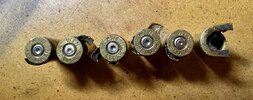9mmGoon
Member
- Joined
- Nov 29, 2023
- Messages
- 76
Back in March this year I decided to try my hand at reloading. I knew my dad had a leftover 3 gallon bucket full of 9mm he ordered from Midway approximately 30 years ago.
I started out with a Hornady load manual and began loading. I used 4.7gn of CFE Pistol,cci primers, 124gn hornady fmj seated to 1.150.
Initial tests were good so i pressed on to 1000 rounds.
I began getting case failures. Seems like 1 in 60 average. I destroyed a glock frame when a case blew out at the head. I began running them in a pcc and have had a few more fail but no damage to the pcc. So im wandering if these cases are too brittle due to age because i have tried different powders, seat depths, primers and the lot but still have case failures.
Thanks for any help.
I started out with a Hornady load manual and began loading. I used 4.7gn of CFE Pistol,cci primers, 124gn hornady fmj seated to 1.150.
Initial tests were good so i pressed on to 1000 rounds.
I began getting case failures. Seems like 1 in 60 average. I destroyed a glock frame when a case blew out at the head. I began running them in a pcc and have had a few more fail but no damage to the pcc. So im wandering if these cases are too brittle due to age because i have tried different powders, seat depths, primers and the lot but still have case failures.
Thanks for any help.
Attachments
Last edited:




